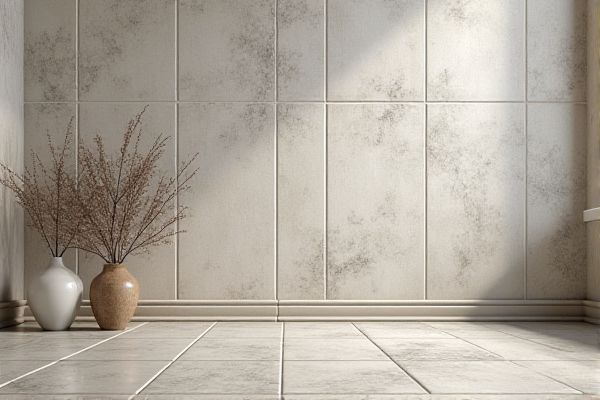
Decorative grout enhances the visual appeal of tiles by adding color and contrast, while neutral grout offers a subtle, seamless finish that blends with the tile for a clean and uniform look. Discover how choosing between decorative and neutral grout can transform Your space by reading the rest of the article.
Table of Comparison
| Feature | Decorative Grout | Neutral Grout |
|---|---|---|
| Purpose | Enhances tile patterns, adds color contrast | Blends seamlessly with tiles, subtle appearance |
| Color Options | Varied, vibrant colors to highlight designs | Muted tones like beige, gray, white |
| Best Use | Accent walls, decorative floors, backsplashes | Large surface areas, minimalist or classic styles |
| Maintenance | May show stains; requires regular cleaning | Easier to maintain; hides dirt better |
| Visual Impact | High contrast, draws attention | Low contrast, creates uniform look |
| Cost | Often higher due to specialty colors | Typically standard pricing |
Introduction to Grout: Decorative vs Neutral
Decorative grout enhances your tile design by adding vibrant colors and patterns that complement or contrast with the tiles, creating a unique visual impact. Neutral grout, typically in shades of gray, beige, or white, offers a subtle, timeless look that blends seamlessly with most tile colors, emphasizing the tile itself rather than the grout lines. Choosing between decorative and neutral grout depends on your desired aesthetic, maintenance preferences, and how much you want your grout to influence the overall appearance of your space.
What Is Decorative Grout?
Decorative grout is a specialized type of grout designed to enhance the visual appeal of tiled surfaces by incorporating colors, textures, and patterns that complement or contrast with the tiles. Unlike neutral grout, which typically uses standard shades like white, gray, or beige to blend seamlessly, decorative grout serves as a design element that can highlight tile layout and add personality to your space. Choosing decorative grout allows you to customize the grout lines to reflect your style and elevate the overall aesthetic of your flooring or backsplash.
Defining Neutral Grout
Neutral grout refers to grout colors that blend seamlessly with tile, such as beige, gray, or off-white, creating a subtle and harmonious look. This type of grout enhances the overall design by minimizing contrast, allowing the tile's texture and pattern to stand out without distraction. When you choose neutral grout, your space maintains a timeless and versatile appeal, complementing various styles and color schemes.
Aesthetic Impact on Tile Design
Decorative grout enhances the aesthetic impact of tile design by adding contrast and highlighting tile patterns, creating a visually striking effect that can define your space. Neutral grout offers a subtle, seamless look, allowing the tiles themselves to stand out without distraction. Choosing between decorative and neutral grout depends on whether you want your grout lines to be a focal point or to blend harmoniously with your tile design.
Color Choices and Visual Effects
Decorative grout offers a wide range of vibrant color choices that can enhance your tile design by creating bold contrasts or complementing patterns for a striking visual effect. Neutral grout, typically in shades like gray, beige, or white, provides a subtle and cohesive look that allows the tiles themselves to remain the focal point while blending seamlessly with various decor styles. Choosing the right grout color influences the overall aesthetic, either by highlighting tile edges with decorative grout or achieving a harmonious, understated appearance with neutral grout.
Grout Selection for Different Spaces
Decorative grout enhances aesthetic appeal by adding color contrast and texture, ideal for accent walls, backsplashes, and creative tile layouts in living spaces and kitchens. Neutral grout blends seamlessly with tile colors, providing a clean and subtle look suited for high-traffic areas like bathrooms and floors where durability and easy maintenance are priorities. Choosing grout based on space function balances design impact with practicality, ensuring long-lasting performance and visual harmony.
Durability and Maintenance Considerations
Decorative grout often contains colorants and additives that enhance its appearance but may require more frequent sealing to maintain durability and prevent staining. Neutral grout typically offers higher resilience and easier cleaning due to its simple composition, making it a low-maintenance option ideal for high-traffic or moisture-prone areas. When selecting grout, consider your long-term maintenance commitment and the durability required for your specific tile installation.
Cost Comparison: Decorative vs Neutral Grout
Decorative grout generally costs more than neutral grout due to its specialized pigments and finishes that enhance tile aesthetics, with prices ranging from $10 to $20 per pound compared to $5 to $10 per pound for neutral options. Your choice affects not only upfront expenses but also potential maintenance costs, as decorative grout may require sealants to preserve color integrity and resist stains. Investing in decorative grout can elevate design appeal while neutral grout offers a budget-friendly, versatile solution suitable for most projects.
Ideal Applications for Each Grout Type
Decorative grout is ideal for creating visual interest in tiled areas like kitchen backsplashes, bathroom walls, and feature floors, where color coordination or contrast enhances the design. Neutral grout suits high-traffic floors and minimalist spaces, providing a subtle, clean look that complements various tile styles without drawing attention away from the tile pattern. Choosing grout based on application ensures durability and aesthetic harmony tailored to specific environments.
How to Choose the Right Grout for Your Project
Selecting the right grout for your project depends on the desired aesthetic and functional requirements; decorative grout enhances design with color and texture, making it ideal for feature walls or artistic tile layouts. Neutral grout, typically in shades of beige, gray, or white, provides a seamless and subtle finish that complements a wide range of tile styles without overpowering the design. Consider factors like grout color impact on tile appearance, maintenance demands, and the project's overall style to achieve a balanced and cohesive result.
 homyna.com
homyna.com